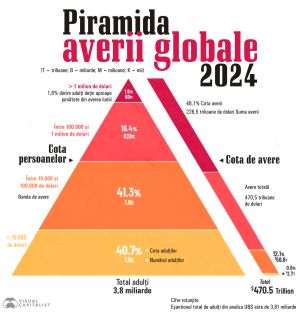The impact of the Federal Reserve's long-awaited interest rate cut, which will be the first cut in four years, will be felt well outside the United States, according to a Reuters article reviewing the possible influence of the central bank's move of the US over other central banks, economies or asset classes.
The size of the first cut and the extent of Fed policy easing are hotly debated as the US election further complicates matters for global investors and monetary policymakers looking for a benchmark in the Federal Reserve and hoping for a soft landing of the economy, writes the mentioned publication.
"We don't know yet what kind of cycle this will be - whether it will be like the one in 1995, when the reduction was only 75 basis points (n.r. 0.75%) or like the one in 2007-2008 when there were 500 basis points basis," said Kenneth Broux, Head of Corporate Research, Stock Markets and Interests, at Societe Generale, quoted by Reuters.
Traders see a 59 percent chance the U.S. central bank will cut interest rates by 50 basis points tomorrow, and a 41 percent chance of a less aggressive 25 basis point cut, according to data released yesterday by the CME FedWatch Tool.
The benchmark US interest rate is currently in the range of 5.25-5.5%, the highest level in 23 years, after a series of hikes in 2022 and 2023 aimed at taming inflation which, following the measures implemented by the American authorities to support the economy hit by the pandemic, had reached the maximum of the last four decades.
• The direction of the leader
The European Central Bank or the Bank of Canada cut rates in 2024 but, at least for the first part of the year, investors wondered how far banks would be willing to go if the Fed did not cut rates this year, before their currencies weakened too much , which puts pressure on prices. Also, interest rate cuts in the United States bring some comfort to regions with weaker economies, according to Reuters.
Thus, as expectations for rate cuts by the Federal Reserve increase, traders are giving more chances for interest rate cuts by other central banks as well. However, they estimate fewer reductions in Europe than in the United States, given that the ECB and the Bank of England are more attentive to inflation risks, the publication also writes.
The start of interest rate cuts by the Federal Reserve is also a boon for global bond markets, which often go hand in hand with Treasuries, according to Reuters.
• More room for maneuver in easing monetary policies and supporting economies
Lower interest rates in the United States may give emerging market central banks more room to ease monetary policy and support domestic economic growth, the source said.
Of the 18 emerging markets sampled by Reuters, roughly half have already started the interest rate-cutting cycle, and Latin America and (emerging) Europe are making sustained monetary easing efforts. On the other hand, volatility and uncertainty related to the US presidential election cloud the outlook.
"The US election will have a major influence on this, as different fiscal policies complicate the rate cut cycle," said Trang Nguyen, global head of emerging market credit strategies at BNP Paribas. "We could see more unusual actions among central banks based on this."
• The weakening of the US dollar?
Economies hoping that interest rate cuts in the United States will continue to undermine the strength of the US dollar, leading to strengthening of their own currencies, may be disappointed, writes Reuters.
According to JP Morgan, the US dollar has strengthened after the Fed's first rate cut in three of the past four cycles.
The outlook for the dollar will largely depend on how rates in the United States compare to rates in other countries, Reuters writes, adding that it is possible that the interest rate differential between the Japanese yen and the Swiss franc could almost halve from dollar, according to surveys by the media trust, while sterling and the Australian dollar could only gain a marginal yield advantage over the US currency.
Unless a low yield truly becomes a currency, the dollar will continue to hold its appeal among non-US investors.
In Asian economies where central banks did not cut interest rates, such as South Korea, Thailand or Malaysia, currencies appreciated in July and August, while the Chinese yuan (the country whose bank is cutting interest rates) recovered losses since the beginning of the year against the dollar.

• Resumption of stock growth
The rally in global shares, which was recently shaken by fears about economic growth, may resume if lower interest rates in the United States will stimulate the economy, so as to avoid entering a recession, writes Reuters.
Global shares, as illustrated by the MSCI International World Price Index, fell more than 6% in a short three-day period in early August following weak US labor market data.
"The market is always jittery around the first cut because investors are wondering why central banks are cutting interest," said Emmanuel Cau, head of European equity strategies at Barclays, adding that usually in the scenario of a rate cut but without showing recession, markets tend to recover.
A soft landing in the US economy should also be beneficial for Asia, although the Nikkei index is down more than 10% from its July record amid strengthening and rising interest rates in Japan, according to the media trust.
• Reducing the opportunity cost of holding precious metals
Precious metals and base metals such as copper should benefit from the Fed's rate cut, with the demand outlook and a soft landing for the economy ultimately key, according to Reuters.
Lower rates and a weaker dollar not only reduce the opportunity cost of holding the metals, but also the cost of their acquisition by those using other currencies, which can support their price.
Ehsan Khoman, Head of Commodities, ESG and Emerging Markets Research at Japanese group Mitsubishi UFJ Financial, says high interest rates have been a "headwind" for base metals, leading to a significant negative distortion in physical demand due to reduced stocks and pressure on certain capital-intensive demand segments.
John Reade, chief market strategist at the World Gold Council, believes precious metals can also benefit from the Federal Reserve's rate cut.
"The performance of gold, which usually has a negative relationship with yields because most of the demand is for investment purposes, usually outperforms the performance of other metals during periods of reduced rates. Gold is at record highs, but investors should be cautious," said John Reade.
According to the strategist, speculators in gold futures markets at Comex (part of the Chicago Mercantile Exchange Group) are positioned for such a scenario. "But, it can be a situation of buying the rumor and selling the fact", drew the attention of Reade, quoted by Reuters.




























































